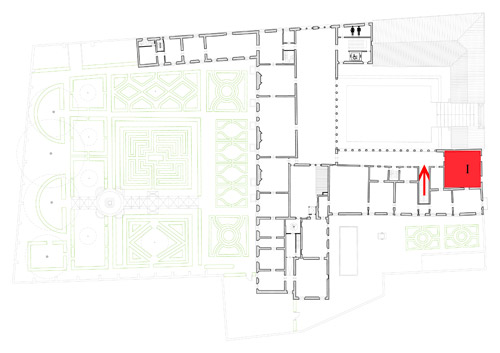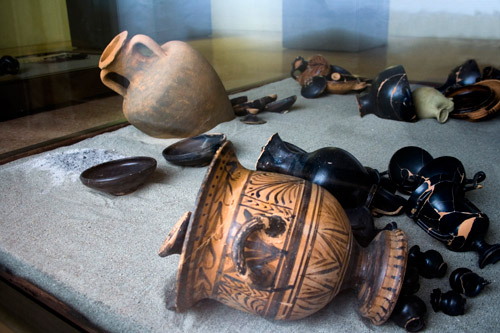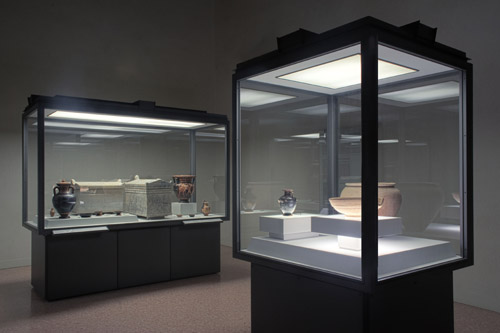The drainage of Valle Trebba (1922) and Valle Pega (1953), have brought to light two different areas of a single large necropolis, hidden under the alluvial deposits of the Po river and its delta. The river Spinete once separated the necropolis from the town, the ancient Spina.
More than 4,000 graves were laid out in fluvial-maritime originated sandy hillocks, that emerged from the lagoon in front of the coastline .
The tombs do not display any external architectural elements and monumentality, are mostly gathered in large groups and marked by memorial stones or river pebbles that probably served as markings for rituals of commemoration.
The discovery of the oldest tombs (fifth century BC) among those placed in later periods, has suggested the existence of family tombs.
The funeral rite in the necropolis of Spina was twofold, with a slight majority of burials in comparison to cremations.
The buried was always oriented in the direction North-West/South-East in accordance with a constant ritual for the entire period the necropolis was used, placed within a wooden chest that sometimes was coated with lime, with the burial offerings placed along the right side of the deceased.
.jpg)
The deceased could carry a piece of bronze in his hand as an offering to Charon, a custom that, according to an old belief, secures a boat ride to the Underworld.
In the case of cremation ashes were collected in a cinerary urn, a coarsely hand-thrown dolium or, rarely, a painted Attic vase or marble urn, also inserted in a wooden box. The burned remains could also be wrapped in a cloth and placed on the bottom of a well, or in a grave with the offerings by their side.
The simplicity of the tombs is in contrast with the objects accompanying the deceased. Artifacts characterized by high quality materials and rich in symbolic content, provide a glimpse throughout the entire lifespan of the Etruscan city (from 540 in the mid-third century BC), and reveal the lifestyle, ideological tendencies and history of the inhabitants of Spina.
The Study of the burial grounds
Studies of necropoles and funeral rites, based on analysis of retrieved objects, allow an anthropological and social interpretation, essential for understanding the lifestyle of ancient communities. The locations of the graves, the types of burial, layout of the corpse which can be evidenced by the clues attained from archaeological excavation, are an essential basis for the reconstruction of the ritual. The objects found in the tombs, examined and catalouged by archaeologists, belonged to the deceased, yet at the same time had their function in the ceremony.
They provide not only valuable information on the society of Spina, on the economic and trade relations with the Greek and Italics, but also reveal how Greek customs permeated the ritual sphere. Some tombs are equipped with such richness and beauty, that only a few parallels can be found in all of northern Italy.
The funeral ritual
The tomb was the physical location of the passage from the world of the living to the world of the dead and the afterlife: the ritual of closing the tomb marked the definite separation between the two spheres. The funeral ritual, which was also an opportunity to show the social status of the deceased, included a set of defined and repeated actions. First of all the women of the community prepared, washed and perfumed the body with oils, afterwards the body of the deceased was exposed in his house for mourning. The body was transported then to the tomb (during the night or at the dawn), followed by the deposition of objects belonging to the dead, and finally the ceremony concluded with libations and sacrifices to divinities accompanied by prayers and invocations that propitiate the journey into the afterlife. Nothing was inserted by chance, from personal property indicators of gender, age and social rank (pottery, weapons, ornaments) to objects used for the funeral banquet (pouring and drinking vases, tools for cooking meat, candelabra) with symbolic offerings (offerings for Charon, pine cones, figurines) and real ones ( slayed animals sacrifices, fruit and first fruits of the harvest, pastries, eggs, milk and wine).
Female graves at Spina, even though presenting similar pottery as male graves, are also characterized by particular and exclusive items such as gold jewelry, amber jewelry, buckles and, more rarely, mirrors, brooches and hair whorls.

Room I
The Museum visit, dedicated to the necropolis of Spina, opens to visitors in a symbolic way, detaching from the chronological criterion that acts as a main guide of the visit, to provide information of a general nature. Before you understand and admire the rich grave findings, there is a presentation of the tomb typology which permits us to get to know the two types of funeral rites, burial and cremation, used from the 540 BC to the second half of the third century BC.

Two graves from Valle Trebba have been reconstructed in the large glass display boxes (483 grave for burial, second half of the fifth century BC, and grave 1082 for cremation of late fourth-early third century BC). The remains of the deceased and the accompanying objects have been found, as in most cases, within wooden chests , buried more than a meter in depth and oriented towards north-west/south-east in line with sandy alluvial hillocks that emerged from the lagoon. The reconstructions have been made possible thanks to the graphic documentation of the excavation diaries.
Very varied in Spina are cinerary containers, of which we have presented an overview from some tombs of Valle Trebba. In the grave 125, marked externally by a large pebble, the ashes were collected in a monumental amphora with lid by the Painter of Kleophades (about 500 BC), while in the grave 207, dated to about 480 BC, a simple dolium was preferred.
Unique are cremation sarcophagi from the tombs 485 and 344 of Valle Trebba, made of blocks of greek marble, perhaps from the island of Paros, between the late sixth and early fifth century BC.

Next room